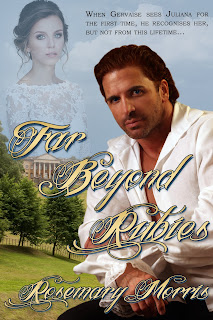 |
| CLICK FOR PURCHASE INFORMATION |
Far Beyond
Rubies by Rosemary Morris is set in England in 1706, during Queen Anne Stuart’s
reign.
When Gervaise, who has returned from India, sees
Juliana for the first time, he recognises her, but not from this lifetime…
My love affair
with history, reading and writing began at a very early age. I agonised over
the story of King Alfred burning the cakes and being scolded by a peasant
woman. At about five-years of age I couldn’t come to terms with a king in a
humble dwelling. In my opinion, Alfred should have been seated on a throne,
dressed in sumptuous clothes, a gold crown studded with jewels on his head.
Aged ten I wept
buckets over Princess Elizabeth, daughter of Anne Boleyn and Henry VIII, seated
on the stairs outside Traitors’ Gate at the Tower of London for fear she would
be executed like her ill-fated mother. Later, I thrilled to Elizabeth’s famous
speech which began: I know I have the body of a weak, feeble woman; but I
have the heart and stomach of a king, and of a king of England too.
This article is
a trip down a proverbial memory lane. I visualise myself in love with, and
cheering for the dashing cavaliers, who fought for King Charles I of England,
and booing Oliver Cromwell, who sanctioned regicide.
My head filled
with the history of old England, I always chose to read historical fiction,
first children’s books; later novels which – to name a few - included Jane
Eyre, The Four Musketeers, Pride and Prejudice, Georgette Heyer’s historical
romances and the Angelique series by Sergeanne Golonne.
Before I could
write I made up short stories. As soon as I could I wrote down tales for my own
entertainment. Eventually, I composed my first historical romance.
At long last, I
studied creative writing. Imagination cannot be taught but the craft of writing
can. My ideas for stories were always good but I needed to learn how to present
them. As I wrote in my previous article, I completed the Open College of the
Art’s writing course, read books on how to write, went on two Writer’s
Holidays, joined The Romantic Novelists’ Association, The Historical Novel
Society and a local writer’s group.
As well as
reading fiction I read historical non-fiction from which I often get an idea
for a novel. After I read William Dalyrymple’s book The White Mughals, I imagined a well-born younger son, who was
packed off to India to serve the East India Company. Sent many miles up country
to establish trade links, all the business was conducted by messenger. During
his years at a Hindu court, isolated from Europeans, the hero of the novel,
whom I named Gervaise, became a vegetarian and took an interest in Hindu
philosophy. I then drew on my knowledge of India and Hinduism to enrich my
novel, which I called Far Beyond Rubies.
When Gervaise
first saw Juliana, it seemed as though he recognised her from a previous
lifetime. After he found out that her half-brother claimed her inheritance and
declared she and her young sister are illegitimate, he offered to help her.
By the time
Gervaise had returned to England and met Juliana, James II’s younger daughter
Anne had succeeded William and Mary. While writing Far Beyond Rubies I wanted
the reader to be swept back into Queen Anne’s reign, to visualise the clothes,
almost taste the food and understand India’s influence on Gervaise. To judge by
reviews of the novel, I achieved not only this but, through the Juliana,
revealed the Jacobite threat to the throne, and the clash of Anglican, Huguenot
and Roman Catholicism, as well as a romance that touches my readers’ hearts.
https;//www.amazon.co.uk/Far – Beyond –
Rubies-ebook/dp/B01MEBL3KX
https;//www.amazon.com/Far – Beyond –
Rubies-ebook/dp/B01MEBL3KX
Published by Books We Love.
Available as e-publications and
paperbacks.
Early 18th century novels by
Rosemary Morris
Tangled Love
Far Beyond Rubies
The Captain and The Countess
Regency novels
False Pretences
Sunday’s Child Heroines born on different days of the week.
Book 1.
Monday’s Child Heroines born on different days of the week.
Book 2
Tuesday’s Child Heroines born on different days of the
week Book 3
















